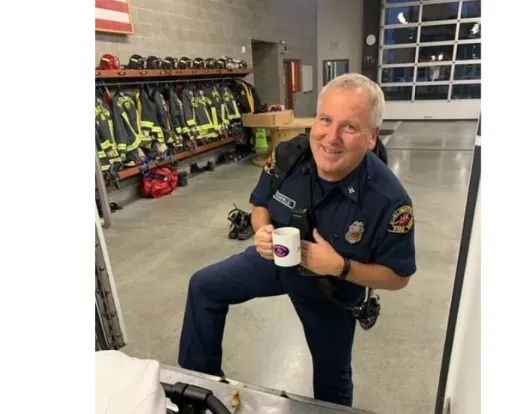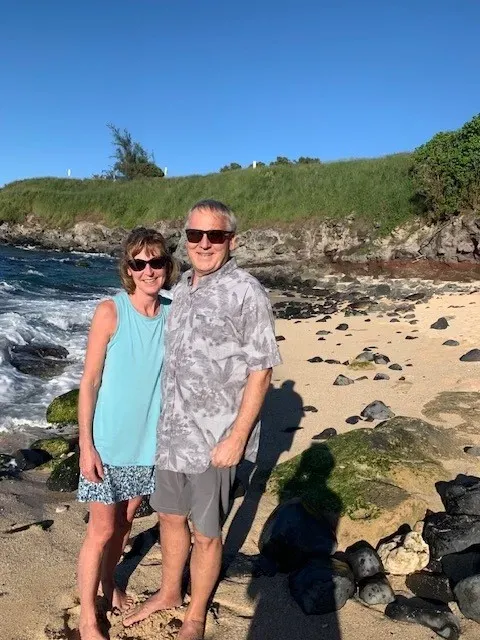An outdoor enthusiast and career firefighter shares how Conquer Cancer–funded research helped restore his quality of life.

“We’re outdoors folks up here in the Northwest,” Jerry says. “We're close to the San Juan Islands. So, we go boating and fishing a lot.”
But Jerry’s adventurous lifestyle was put on pause in early 2022 when his loved ones noticed his skin appeared jaundiced. A career firefighter for 33 years, Jerry was just one month away from retirement when he received the devastating news: He was diagnosed with multiple myeloma, an incurable type of blood cancer.
“It was scary. I had just lost my colleague to multiple myeloma,” Jerry recalls. “We were career-long firefighters together. And I’m going, oh, man, I have the same thing my buddy got.”

A Strategic Approach to Supportive Care
While standard therapies for multiple myeloma are generally effective, they’re also known for being physically and emotionally taxing on patients. The consequence is frequently a reduced quality of life—a reality compounded by the feelings of hopelessness that often come with an incurable cancer diagnosis. Fortunately, Rahul Banerjee, MD, a Conquer Cancer grant recipient, is working to address this problem through research.
Though today he focuses on multiple myeloma, Dr. Banerjee’s first clinical research project examined how providers approached discussions of fertility issues for younger patients with breast cancer. The study, he remembers, revealed a significant need for better supportive care.
“This opened my eyes to one of the biggest challenges in oncology: As cancer treatments get more and more specialized, how do we improve supportive care and survivorship down the line?” says Dr. Banerjee, who is based at the Fred Hutch Cancer Center in Seattle, Washington. “We felt that if we could develop a strategy to help patients build resilience during stem cell transplantation, then those strategies would hopefully become self-sustaining to help patients in years to come.”
As Dr. Banerjee began thinking of how to advance supportive care research, he and his research mentors noticed that many of their patients with multiple myeloma began taking certain prescription medications for sleep and anxiety within one year of diagnosis. The side effects of these drugs, however, made enduring several rounds of myeloma treatments even more challenging for patients.
“Our patients with multiple myeloma are already on so many pills, and we wondered whether these new medications were contributing to that,” says Dr. Banerjee, who thought of innovative ways to help patients undergoing stem cell transplantation to better manage their well-being and receive adequate psychosocial support.
Coaching Through an Incurable Cancer
In 2020, supported by a Conquer Cancer grant, Dr. Banerjee launched a clinical study measuring the effectiveness of digital life coaching (DLC) for patients undergoing stem cell transplantation for multiple myeloma. DLC pairs patients with a life coach to help them achieve personal care goals related to exercise, sleep, nutrition, and stress reduction. Dr. Banerjee, a member of Jerry’s cancer care team, recommended he enroll in the study.
“I was low on energy and trying to get back to being more active,” Jerry recalls. “Dr. Banerjee mentioned that he had clinical research going on, and I was all about supporting it and getting involved.”
The study connected patients with 16 weeks of access to a certified life coach via mobile device and compared their experiences to another group of patients who received standard care during the same treatment. Participants completed weekly surveys that assessed symptom management, mental and physical health, progress toward care goals, and overall quality of life.
“My life coach would call every Monday,” says Jerry, “and I’d get my questionnaires to evaluate how I’m doing with making sure I’m taking my medicine and how I’m feeling and what my goals were.”
“Jerry’s life coach was a real motivator,” Judi says. “She would ask questions like, ‘What do you want your goal to be for next week when I talk to you? What are some additional things you can do to get there?’ She was there to listen and wanted to motivate and encourage him.”
Dr. Banerjee and his team found that patients who received DLC experienced improved physical quality of life following treatment, along with significant reductions in emotional distress. Jerry, Dr. Banerjee says, is an example of how DLC can have a profound impact on patients with multiple myeloma. The consistent support provided by DLC helped Jerry to better manage some of the symptoms associated with multiple myeloma and its treatment. It also encouraged him to gradually return to a more physically active lifestyle.
“Multiple myeloma has caused some neuropathy in my feet,” Jerry explains. “They often feel like they’re asleep and numb, which has affected my ability to do outdoor activities like cycling, boating, and hiking.”
But, he continues, participating in DLC helped Jerry build greater physical stability compared to how he felt during and immediately after treatment. “I hadn’t done any strength training in a long time, so my life coach and I focused on improving my aerobic fitness,” Jerry says. “It was great to have the DLC support in my toolbox to help get me going again.”
Get Your Steps In: Pairing DLC With Fitness Trackers
After his initial DLC study, Dr. Banerjee and his team launched two active studies of DLC in patients with recurrent multiple myeloma. This research includes giving patients a wearable device that monitors their physical activity during treatment. By pairing the wearable activity tracker with the accountability provided by a life coach, Dr. Banerjee is testing whether the two wellness strategies can improve on each other. Jerry is participating in these studies and seeing positive results.
“This combination helped a lot,” he says. “I had previously gotten so weak that I was using a walker to get around.”
Now, instead, Jerry is monitoring his steps throughout the week, and—more often than not—he gets his 10,000 steps in, on top of staying busy chasing his grandkids around the backyard.
“Being able to get out with Judi, my boys, my grandkids and enjoy outdoor hobbies with them again has been so meaningful to me,” Jerry says. “I’m going on trips and boating and engaging in similar activities that I couldn’t do before participating in Dr. Banerjee’s research study. I’m getting my strength back.”
“I think the research has really boosted him, because he was struggling,” Judi says. “I mean, he didn’t want to get out of the chair. For two years, he was kind of just down and out. So, when Dr. Banerjee’s study came about, I think it just really put that extra boost in Jerry to take manageable steps and help get his life back.”
Improved Supportive Care: A Promising Future
Today, Jerry remains on a regular chemotherapy regimen to help keep the cancer at bay. He also does monthly bloodwork so his care team can monitor for any potential signs of recurrence.
“Multiple myeloma can return, so every month we hold our breath,” Jerry says. “It’s like, ‘OK, are the numbers still down?’ But so far, everything’s looking good.”
He and Judi credit much of his treatment and post-recovery success to the power of cancer research.
“If we didn’t have research, Jerry probably wouldn't be here,” Judi says. “From the first time his providers asked him to sign papers to enroll in research studies, he said yes, because he wanted future patients to have the opportunities that he was having.”
Five years from now, Dr. Banerjee anticipates that further advances in DLC will further improve supportive care and reach a greater variety of patients.
Approached effectively, Dr. Banerjee says, DLC can help patients meaningfully improve their lives and allow their coaches to gain nuanced insights into their patients’ unique care needs.
For Jerry, that meant gradually returning to an active lifestyle, engaging in his favorite outdoor activities again, and spending quality time with his loved ones.
“Dr. Banerjee said that he’s not going to give up on us,” Judi says. “And that’s what we keep thinking about: How researchers like him are doing so much work to continue the research, so that patients like Jerry can return to a normal life.”
Read about Dr. Rahul Banerjee and his Conquer Cancer–funded research.



